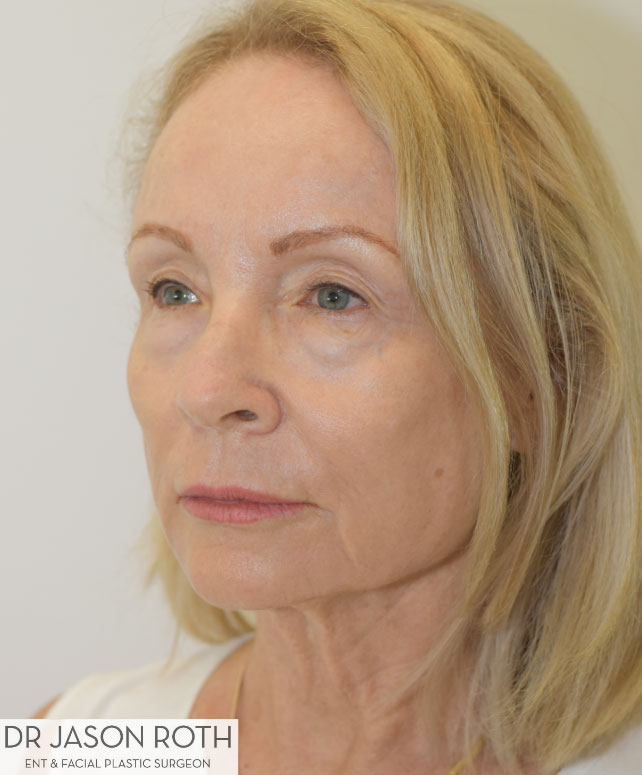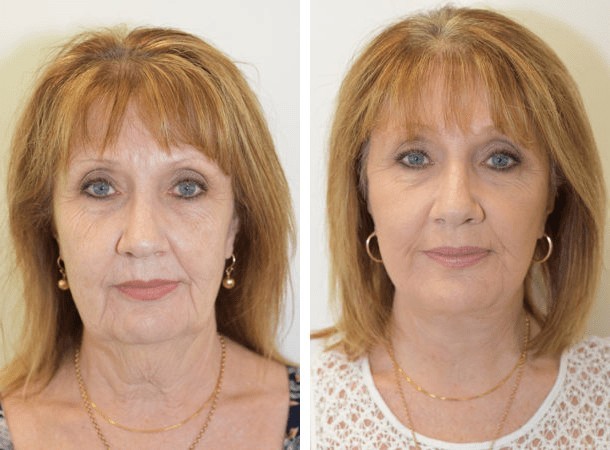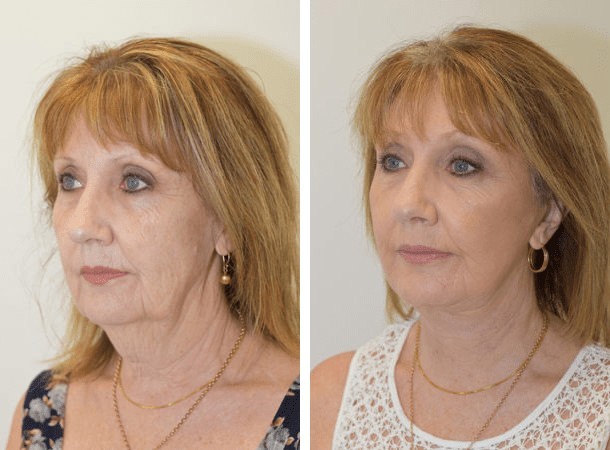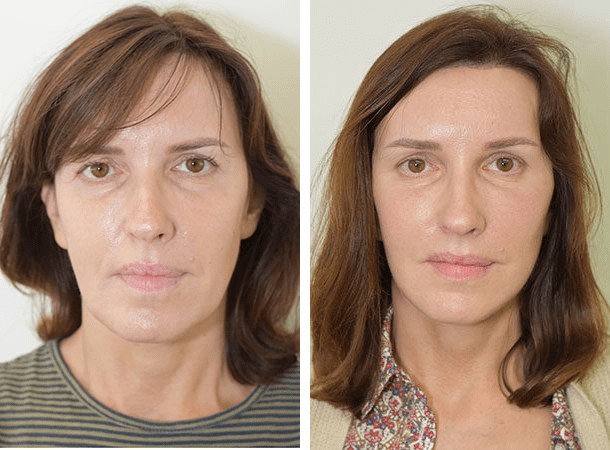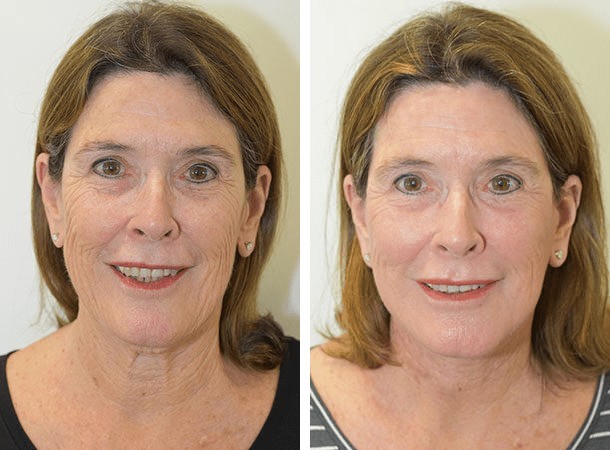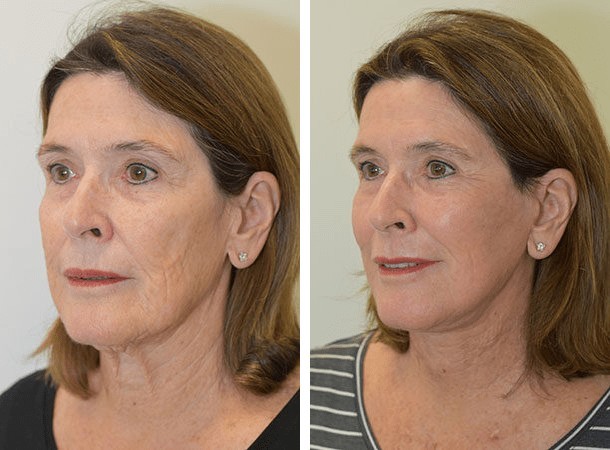Deep Plane Facelift in Sydney
Deep Plane Facelift Information
Actual patient of Dr Roth 6 months after deep plane facelift
Click here to view more photos
The facelift is an operation that can address some of the changes of ageing in a significant and permanent fashion. Unlike injectables, which can make the face appear full, paralysed or just unnatural, a well performed facelift can alter the face and neck in a natural manner.
The facelift operation has evolved significantly over time. Early facelifts were done by tightening skin alone. This can lead to a ‘tight’ appearance in the face that looked unnatural. The results also tended not to last for more than a couple of years. Further research determined that a more permanent and natural result could be obtained by tightening a deeper layer in the musculature of the face, known as the superficial muscular aponeurotic system or SMAS. The SMAS lift can obtain good results and is commonly practiced. The Deep Plane Facelift has been the next evolution.
Dr Roth performed SMAS lift facelifts for many years before shifting to the deep plane facelift technique. He was impressed by the results as well as the improved recovery of his patients with this technique.
The deep plane facelift lifts a layer of tissue which is fibrous and inelastic. Unlike the skin which is very elastic and has a tendency to re-stretch over time, the deep plane facelift is durable. Results should last 10 years or longer, longer than a traditional skin or SMAS lift. The deep plane facelift creates natural results and avoids the stigmata of tightness that can occur with other facelifting techniques.
Risks of surgery
Cosmetic surgery is a serious decision. Information about the risks of a facelift can be found here.
What is a Deep Plane Facelift?
The key distinguishing feature of a deep plane facelift is that it lifts only the muscle layer (the SMAS), leaving the overlying skin attached. This means that the skin never looks tight or unnatural. It also releases important tethering points in the cheek area and along the jawline. This allows the muscle layer to re-drape in a very smooth fashion under minimal tension. The addition of fat or filler is usually unnecessary.
The “deep plane” is a term used to define the tissue layer between the SMAS and the muscles of facial expression which lie deep to it. The muscles of facial expression are covered by a thick layer of fascia so are easily identified by a properly trained surgeon. The deep plane facelift releases the SMAS muscles with their attached skin and fat and repositions them. This avoids pulling on the skin or removing excessive amounts of skin.
Four ligament groups need to be released in order to allow adequate movement of the structures of the face and neck.
- The zygomatic ligaments connect the cheek skin to the underlying bones. In order to elevate the cheeks they need to be released. A youthful face can often appear “heart-shaped” with more volume in the upper part of the midthird compared to along the jawline. Once the zygomatic ligaments are released, tissue can be moved upwards to create this heart-shape. Additional filler, fat or cheek implants are not necessary. Releasing these ligaments also helps to elevate tissue into areas of hollowing under the eyes and lift the nasolabial folds.
- Mandibular retaining ligament. This ligament tethers the tissues along the jawline near the chin. When it is released lines around the chin as well as the anterior jawline are often improved.
- Masseteric cutaneous ligaments. These ligaments tether tissues along the angle of the jaw. Once they are released they allow the entire jawline to becomes smoother and tighter.
- Cervical retaining ligaments. The deep plane facelift is extended down into the neck to allow re-draping of the neck tissues in continuity with the facial tissues. This assists with creating changes that are long lasting. Traditional SMAS lifts can sometimes cause tissue to be bunched up around the back of the jawline. By lifting tissues back up into the face rather than at the back of the jaw this problem is avoided.
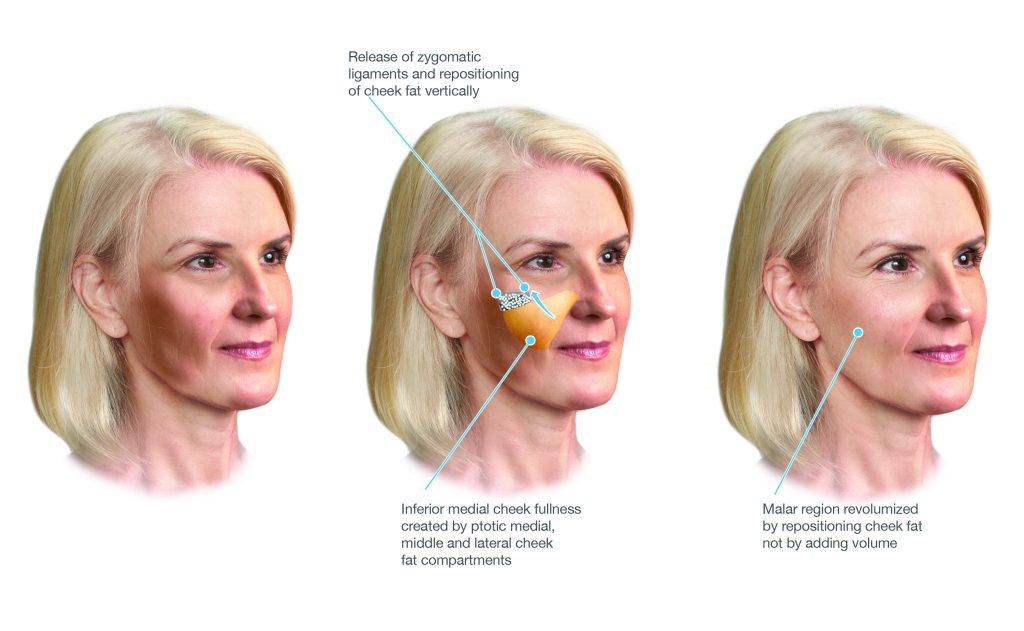
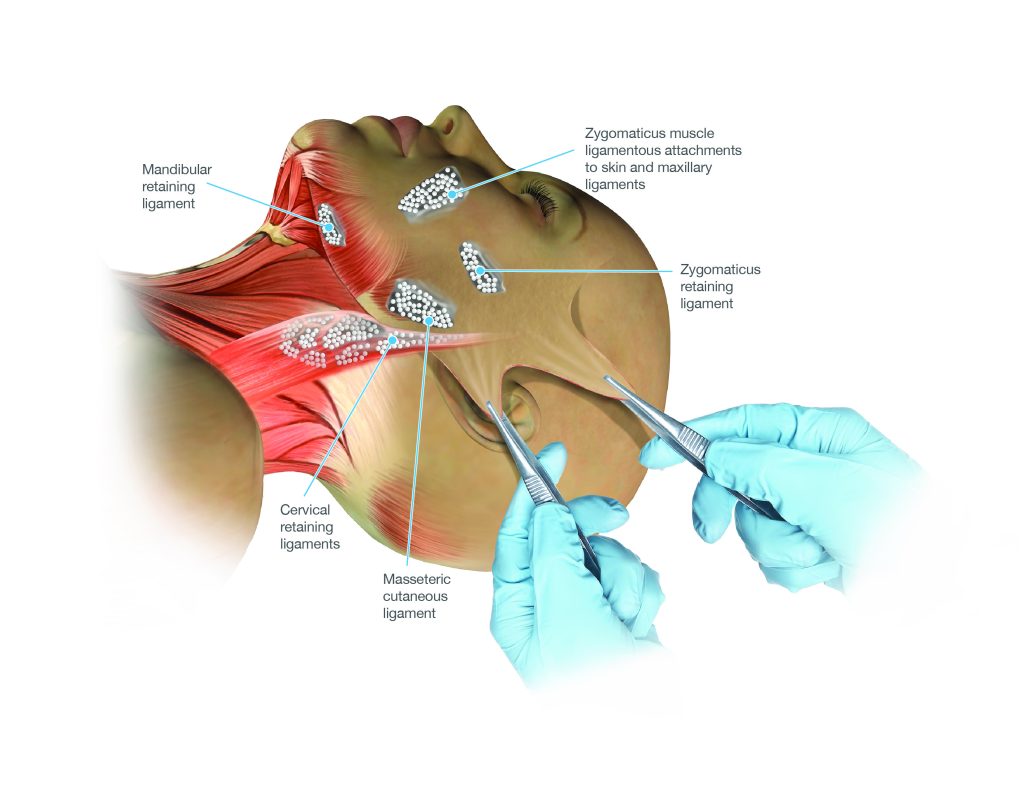
Vertical Lifting
Traditional facelifts often focused on stretching skin backwards towards the neck and ears. This sometimes gave the face a very stretched appearance. This type of lift can also flatten the cheeks. Even the corners of the eyes or the mouth would sometimes be pulled sideways. A deep plane facelift uses a vertical vector to lift tissues upwards rather than backwards. This creates a much more natural facial contour. The cheeks become volumised, corners of the mouth can be altered from downward pointing to slightly upward. The actual best angle that tissues need to be lifted tends to become more vertical as we age and needs to be customised to each patient.
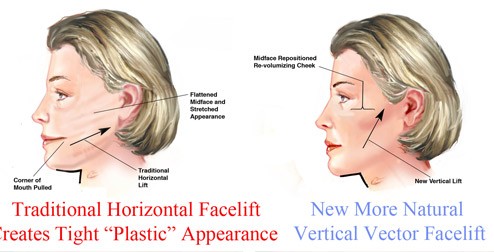
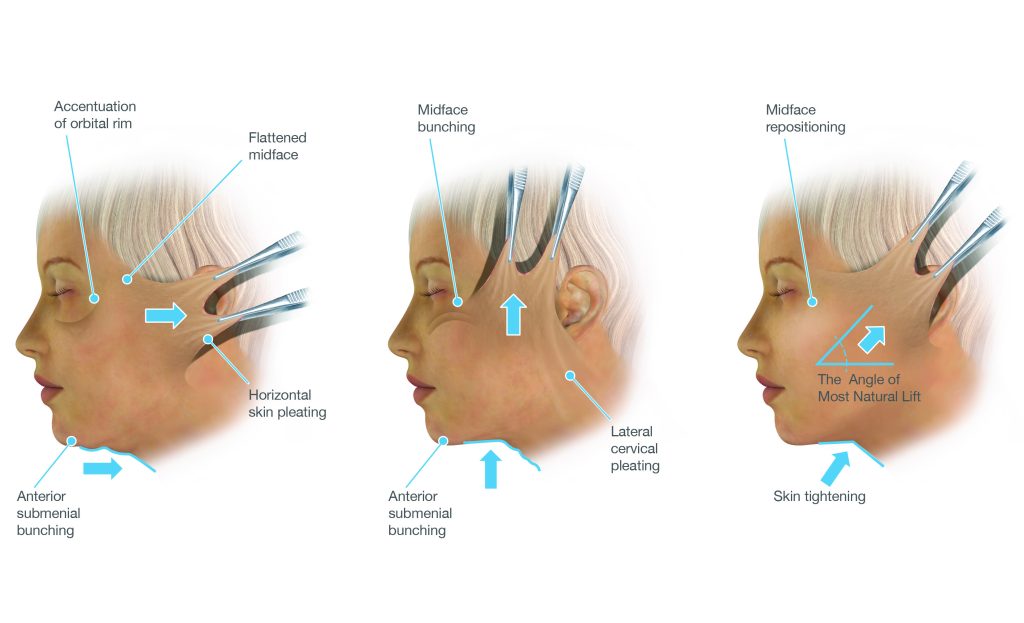
Platysmaplasty
A deep plane facelift may need to be combined with a procedure in the midline of the neck called a platysmaplasty. The free edges of the platysma muscle often sag down into the neck creating two vertical lines an inch or so apart from the midline. A small incision may need to be made just under the chin to identify these muscle bands and suture them together. This creates a type of muscle sling that can be used to lift up any loose fat in the neck. The incision under the chin is very well hidden. In the majority of patients the deep plane facelift creates sufficient lift that a platysmaplasty is not necessary.
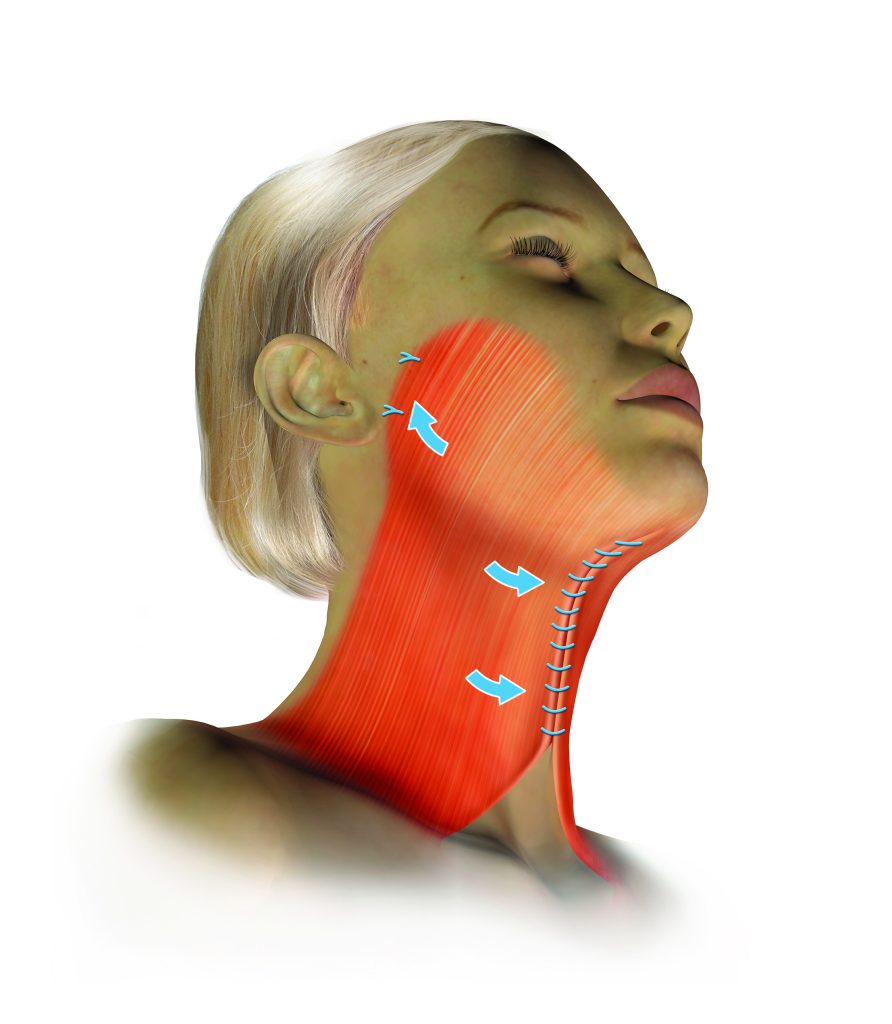
Image depicts the underlying muscle bands of the platysma being sutured back together as a platysmaplasty
Deep Plane Facelift vs SMAS
The SMAS facelift remains a very popular facelift technique performed around the world, particularly in the United States. Typically a type of SMAS lift called a “SMAS plication lift” is performed. This is not a deep plane facelift. In this surgery, the skin is completely lifted off the SMAS and then sutures are placed within the SMAS to tighten it. This can give a very easily spotted look “like you had a facelift”. Pulling on the SMAS gives better results than lifting the skin alone but a SMAS facelift can create a very tight look in the skin.
A SMAS facelift can really only effectively treat the lower face and jaw well. Descent of skin and muscle from around the cheeks is often not well addressed. This means that some surgeons then perform fat grafting at the same time. This can make the cheeks seem overfilled as the underlying problem of descent of tissues has not been corrected. The deep plane technique repositions muscle and fat of the face back into it’s proper position as a continuous unit.
Deep Plane Facelift Recovery
You can expect bruising of some areas of the facial and neck skin for at least two to three weeks after a deep plane facelift. Swelling of the face occurs the morning after surgery and typically lasts longer than bruising. The swelling will be significantly improved by 2 weeks but will continue to decrease in size over around 6 weeks. If due to work or social commitments, you want almost no visible evidence of healing after a facelift, you may need to wait at least 6 weeks. Scars can stay a red colour for much longer before finally fading to white.
The bruising and swelling in the face from a deep plane facelift is less than with a standard SMAS facelift. This is because the deep plane technique is performed in a natural tissue plane layer that does not usually have many blood vessels within it. In addition the attachments from the skin to the SMAS layer underneath it are left undisturbed for most of the face, again leading to less skin bruising and swelling. SMAS facelifts typically disrupt the attachments between the skin and SMAS.
Typically patients feel little to no pain after surgery. Head elevation and cold compresses can be helpful to assist with reducing swelling.
Deep Plane Facelift Scars
The deep plane facelift leaves the most hidden scars of any facelift surgery but they are never totally hidden. Due to the fact that tissues are lifted in a deep layer, little to no tension is placed on the skin. This allows the skin edges to heal close together with the best possible scars. Over 12 months, scars will appear as very fine lines. Another key benefit is that this technique can help prevent the earlobes from being pulled downwards which can create a deformity, although this risk is not totally removed.
Advantages of the Deep Plane Facelift
- More natural results by repositioning the SMAS and platysma layer
- Restoration of natural volume an elevation of the cheeks (no need for fat grafting or facial implants)
- Shorter recovery time
- Better scars
- Longer lasting result
- Improved nasolabial folds
- Smoother skin
Am I a Candidate for a Deep Plane Facelift?
A deep plane facelift can be done in both men and women. It can assist with changing a range of age related changes in the face and neck. This includes jowls along the jawline, platysmal vertical bands in the neck and other areas of descended skin and muscle around the midface and mouth. Patients should be in good physical health. During your consultation with Dr Roth, he will be able to advise if you are a suitable candidate for a deep plane facelift.
To learn more about this procedure, please contact us to arrange an appointment with Dr Roth
About Dr Jason Roth, MBBS, FRACS
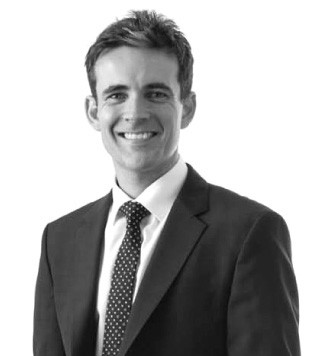
Dr Jason Roth is a Sydney Otolaryngology Specialist and Head & Neck Surgeon with Facial Plastic Surgery Fellowship training from Australia, the United States and Europe. He is an expert in Facelift Surgery, Rhinoplasty, Nose and Sinus Surgery.
He consults from his clinic in Dee Why and operates at several private hospitals across Sydney. Importantly, Dr Roth performs more than 50+ facelifts per year, which makes him one of Sydney’s busiest facelift surgeons. Dr Roth has exposure to a high volume of patients with both common and rare clinical problems, allowing him to develop a depth of expertise. View his full profile here.
Facelift Before and After
66 year old lady who underwent a deep plane facelift, neck lift, hairline advancement, septorhinoplasty and lower eyelid blepharoplasties.
The post-operative result at 6 months. Results vary from person to person.
Cosmetic surgery is a serious decision. More information about the risks and recovery of each procedure is available on our website.
All surgery performed by Dr Jason Roth (MED0001185485), Otolaryngology head and neck surgeon, Sydney.
Facelift Before and After
61 year old lady presenting for treatment of her neck, facial wrinkles and heavy brows.
The patient underwent a deep plane facelift, neck lift and brow lift.
Her post-operative photographs are at 6 months.
Facelift Before and After
52 year old lady who underwent a deep plane facelift, necklift with platysmaplasty, browlift with hairline advancement and nasal airway surgery to improve breathing.
Post-operative photos taken at approximately 12 months following surgery.
Results vary from person to person.
Cosmetic surgery is a serious decision. More information about the risks and recovery of each procedure is available on our website.
All surgery performed by Dr Jason Roth (MED0001185485), Otolaryngology head and neck surgeon, Sydney.
Neck Lift Before and After Patient 5
70 year old lady who underwent a deep plane facelift and a necklift with a platysmaplasty.
The patient was particularly keen to smooth out some of her very deep facial wrinkles.
Post-operative photos taken at approximately 3 months following surgery.
The patient is booked in to have some CO2 laser skin resurfacing which will further improve her result. Results vary from person to person.
Cosmetic surgery is a serious decision. More information about the risks and recovery of each procedure is available on our website.
All surgery performed by Dr Jason Roth (MED0001185485), Otolaryngology head and neck surgeon, Sydney.

